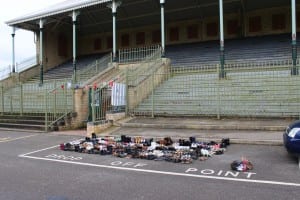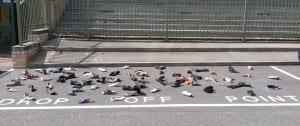‘If the dramaturg attempts to sketch a “map”, perhaps this will always be in pragmatic and tentative relation to the territory of the performance event (Turner, 2010, p.150).
The quote above, by Cathy Turner, best describes the way in which our performances at the grandstand are relevant to the site. We as performers are creating a “map” or what could be seen as a “timeline” of the grandstand’s history by showing glimpses into it’s past in our pieces. For example we have settled on portraying the morgue, that could have been at the grandstand, in our performance and this is done in a serious manner but our ideas are based on the facts we know about the site and are not true portrayals. They are our interpretations of the knowledge we have of the grandstand, however we are bringing the history of the site to life.
Turner also goes on to say what elements she feels creates a performance, ‘Thus there is a dynamic, contextual and indeed, political dimension to dramaturgical practice’ (Turner, 2010, p.150). Turner believes that performances are dynamic, contextual and political. Is this true? This is what I am going to establish witht this blog. I am asking myself, do we need all 3 of these elements to make a performance?
The one element I completely agree on is context; I believe it is mandatory within a piece. If you have no context, then you have no point and without a point you really don’t have a performance. Drama pieces originate from ideas and that is your focus. In our case, we are performing at the grandstand so our piece is in context with the historical past of our site. If our piece was performed somewhere else, it will still work as a piece but it would be out of context and would therefore be less effective for the audience to watch.
Does a performance need to be political? If your piece has a strong stance on an issue it will create a bigger reaction from the audience and will make them feel something. Is it crucial? If you want to cause the audience to have strong emotions to your piece then, yes, of course you would take a political approach but many performances can be done without a political message. However many plays have issues that have a moral standpoint and so it is very hard to be a part of a performance which does not feature a type of politics.
Dynamic performances tend to be the most interesting of pieces, as they push the boundaries and keep the audience’s attention. All performance pieces need to be different to stand out; every version of a play you will ever see will have a different dynamic. Although a performance doesn’t have to be dynamic to be performed, it is the best way for a piece to be successful. As audiences are constantly changing, drama pieces should also be adapting to match those watching it.
Having considered Turner’s ideas, as to what makes a drama piece, I would agree that it is essential to have a dynamic, contextual piece. As for political, it depends on everyone’s definition of political issues. I believe there should be an issue that is explored in a drama piece to make it truly successful but whether it is always political is dependent on an audience’s interpretation.
Work Cited
Turner, C. (2010) ‘Mis-Guidance and Spatial Planning: Dramaturgies of Public Space’, Contemporary Theatre Review, Vol. 20(2), Routledge, P.149-161

![20140508_102554[1]](https://sitespecific2014mpi.blogs.lincoln.ac.uk/files/2014/05/20140508_1025541-300x168.jpg)
![20140508_134424[1]](https://sitespecific2014mpi.blogs.lincoln.ac.uk/files/2014/05/20140508_1344241-300x168.jpg)
![20140508_134446[1]](https://sitespecific2014mpi.blogs.lincoln.ac.uk/files/2014/05/20140508_1344461-300x168.jpg)


![20140307_102352[1]](https://sitespecific2014mpi.blogs.lincoln.ac.uk/files/2014/03/20140307_1023521-300x168.jpg)
![20140307_111710[1]](https://sitespecific2014mpi.blogs.lincoln.ac.uk/files/2014/03/20140307_1117101-300x168.jpg)
![20140307_111724[1]](https://sitespecific2014mpi.blogs.lincoln.ac.uk/files/2014/03/20140307_1117241-e1395844710849-168x300.jpg)